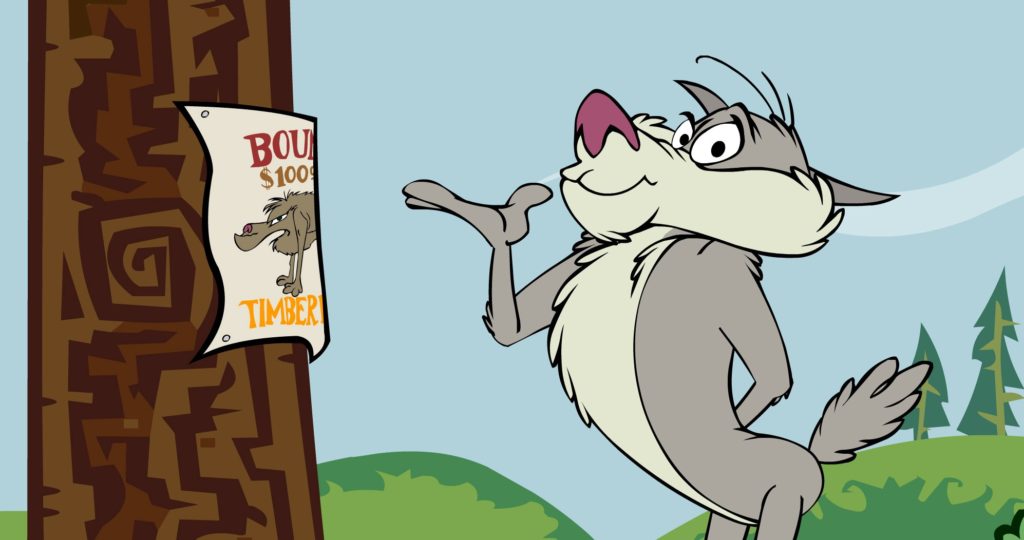We’re obsessed with Chuck Jones. One of the early name candidates for this publication was, in fact, “Jonesland,” if you’ll believe it. (Like, err, Grantland… but for cartoons! Fun, right? OK, fine.) Luckily, we went with a nod to one of his best shorts instead, and the rest is history.
Today, let’s take a look at the last thing Jones did. Called Timber Wolf, it was a short web series that released 13 episodes on WarnerBros.com in 2001. It looked like this:
All of the action in the simple series of shorts revolves around the eponymous character, Thomas T. Wolf. The “T” stands for Timber, a word he cannot say (or allow others to say) without incurring the terrible pain of a falling tree crashing down on his head. Naturally, this happens several times an episode. The great Joe Alaskey, known for succeeding Mel Blanc as the voice of several Looney Tunes characters, voiced the smooth-talking wolf, and Nancy Cartwright (best known as Bart from The Simpsons) appears in a few episodes as a gun-toting antagonistic squirrel.
Thomas himself might sound to a modern audience like a precursor to Kevin Spacey’s Frank Underwood on House of Cards—down to the Southern accent, educated manners of speech, and penchant for breaking the fourth wall. He introduces each episode, and almost always furnishes his own undoing. Through it all, he remains as cheerful as Bugs Bunny, as doomed as Daffy Duck, and as pompous a know-it-all as Foghorn Leghorn.
He falls squarely in the anthropomorphic tradition of Jones’s past Looney Tunes creations. Much like the rules he established for Wile E. Coyote and the Road Runner, Jones and the team behind these Flash cartoons—which was supervised by his final protégé, executive producer Stephen A. Fossatti—stuck religiously to the conceit, finding new and creative ways to demolish their main character over and over again. Every time, it pays off beautifully.
It’s unclear how much Jones was actually involved in the production beyond creating the concept. He’s credited as one of four producers on each episode, but no one involved with the production that The Dot and Line reached out to has responded to requests for comment.
This only adds to Timber Wolf’s legacy as an odd little time capsule of an Internet that no longer exists and a style of animated comedy that largely passed away with its creator. It’s a slickly produced artifact of the Flash era, throwing back to the pre-YouTube days of Newgrounds, DSL modems, message boards, and the Space Jam website—written with the comedic approach and timing of classic Looney Tunes shorts. You can watch every episode of Timber Wolf for free on YouTube or at FredEdison.Free.fr, playable in their original .SWF format, complete with the Flash mini-games that ran with each one.
The show premiered and aired on the Warner Bros. website in 2001 with no promotion (at least none I can recall) on Cartoon Network or any of the company’s other outlets devoted to Jones’ previous work, and so no substantial nostalgic community exists to breathe new life or an Animaniacs-like surge of Netflix love into it. But it’s still a Jones show, and the world deserves to know it was there.
“There’s a little bit of Chuck Jones lodged in the frontal lobe of everyone here tonight,” the late Robin Williams told an audience of 45 million people who tuned in to watch the 1996 Academy Awards. There, he handed an Honorary Academy Award to and 83-year-old Jones to an ecstatic standing ovation and an orchestral take on the classic Looney Tunes theme.
Jones, predictably, comported himself in a manner befitting a gentleman. “I stand guilty before the world of directing over 300 cartoons in the last 50 or 60 years,” he said, brandishing the Oscar. “Hopefully this means you’ve forgiven me.”
Jones departed from this world in 2002, but cartoons like Timber Wolf will live forever, their antics and signature refrains delighting to the very end. Tiiiiimbeeerrr!
Welcome to The Dot and Line — a new Medium publication that aims to take animation of all kinds seriously (but not too seriously). If you liked what you read, recommend this article and follow us on Twitter and Facebook.
